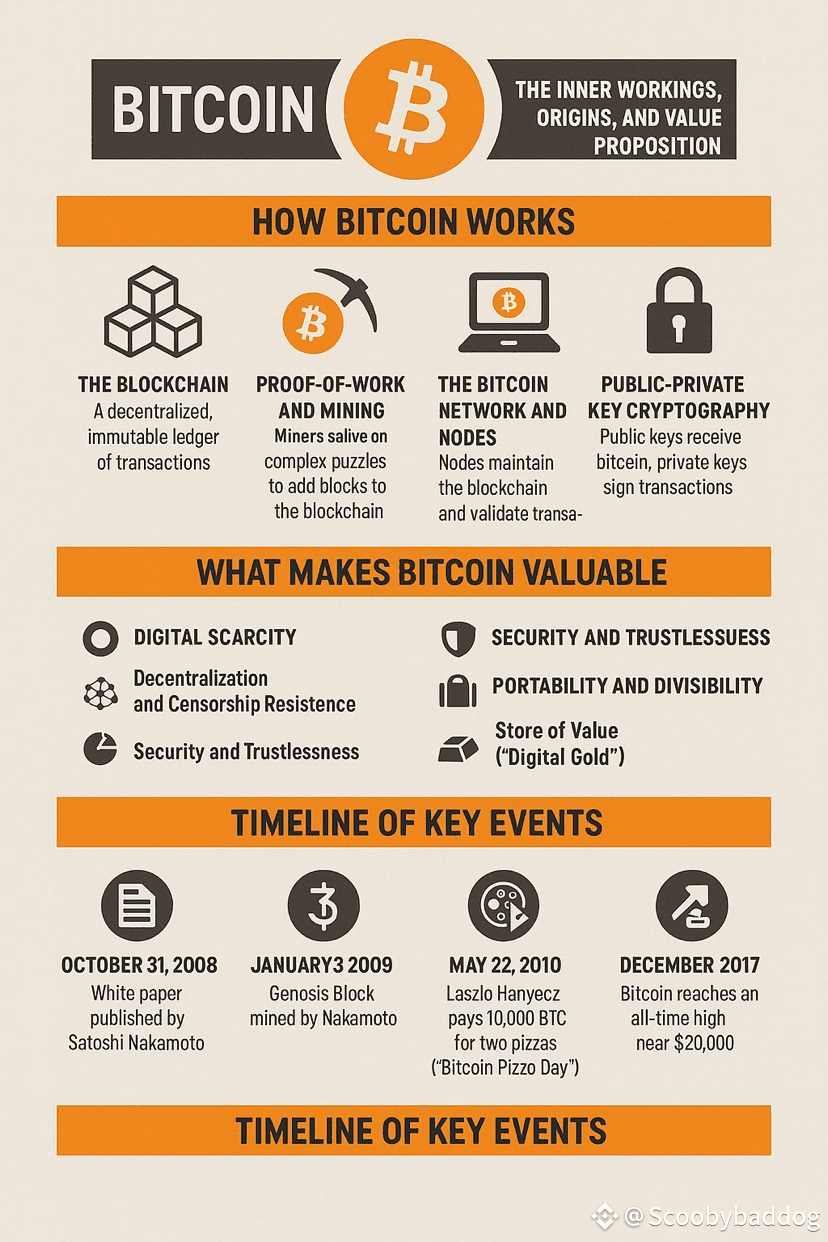Bitcoin is often described as digital gold, a decentralized currency, and a revolutionary financial technology. Since its mysterious inception in 2009, Bitcoin has evolved from an obscure cryptographic experiment into a global financial asset with a market capitalization in the hundreds of billions of dollars. But what exactly is Bitcoin? What makes it valuable? And how does it work under the hood?
This article unpacks the creation, mechanics, and value drivers of Bitcoin, shedding light on why it continues to play a pivotal role in the ongoing transformation of the financial world.
Origins: The Genesis of Bitcoin
Bitcoin was born out of the ashes of the 2008 financial crisis—a time of deep mistrust in traditional financial institutions. On October 31, 2008, a person or group under the pseudonym Satoshi Nakamoto released a white paper titled “Bitcoin: A Peer-to-Peer Electronic Cash System.”
The paper proposed a system of electronic transactions without relying on trust, meaning no need for central banks or third-party intermediaries. In January 2009, the Bitcoin network went live when Nakamoto mined the genesis block (Block 0), embedding in it the now-famous message:
"The Times 03/Jan/2009 Chancellor on brink of second bailout for banks."
This was both a timestamp and a political statement. Bitcoin was conceived as a countermeasure to systemic instability, aiming to offer an alternative monetary system outside of government control.
How Bitcoin Works: The Technical Mechanics
At its core, Bitcoin is a decentralized digital currency powered by a peer-to-peer (P2P) network. Here's a breakdown of its primary components:
1. The Blockchain
Bitcoin operates on a blockchain, a type of distributed ledger that records every transaction ever made.
Blocks: Each block contains a list of transactions, a timestamp, and a reference to the previous block via a cryptographic hash, forming a chain.
Immutability: Once added, blocks cannot be altered without redoing the proof-of-work for that block and all subsequent blocks—an almost impossible task.
2. Proof-of-Work and Mining
To add a block to the chain, miners compete to solve a complex mathematical puzzle known as proof-of-work (PoW). This process ensures that:
Only valid transactions are recorded.
Network participants (miners) are incentivized to play by the rules.
The system remains decentralized and secure.
Once a miner finds the correct hash (a 256-bit number that meets the network’s difficulty target), they broadcast the block to the network. If other nodes validate it, the block is added to the blockchain, and the miner earns a block reward in newly minted bitcoins plus transaction fees.
3. The Bitcoin Network and Nodes
Bitcoin is maintained by thousands of nodes—computers that store a copy of the entire blockchain and enforce consensus rules (like block size, transaction format, etc.).
Full Nodes: Independently verify all transactions and blocks.
SPV (Simplified Payment Verification) Nodes: Use a lighter model, verifying transactions via Merkle trees without storing the full blockchain.
4. Public-Private Key Cryptography
Bitcoin uses asymmetric cryptography:
Public Key: Functions as an address to receive bitcoins.
Private Key: A secret number that allows the holder to spend bitcoins.
Ownership of bitcoin is established by having the private key corresponding to the UTXOs (unspent transaction outputs) associated with a public address.
5. Supply Cap and Halvings
Bitcoin has a fixed supply of 21 million coins. This is enforced by:
Block reward halvings: Every 210,000 blocks (roughly every 4 years), the reward for mining a block is halved.
Originally, the reward was 50 BTC. As of 2024, it’s 3.125 BTC per block.
This built-in scarcity is modeled after gold and plays a huge role in Bitcoin’s value proposition.
What Makes Bitcoin Valuable?
1. Digital Scarcity
Bitcoin is the first digital asset with verifiable scarcity. Unlike fiat currencies that can be printed at will, Bitcoin’s supply is predetermined and immutable. This makes it resistant to inflation and supply manipulation.
2. Decentralization and Censorship Resistance
Bitcoin’s decentralized nature makes it:
Immune to government seizure or manipulation (in most cases).
Accessible to anyone with an internet connection.
Resilient to censorship, as transactions cannot be easily blocked or reversed.
3. Security and Trustlessness
Transactions are secured by immense computing power (hashrate).
There’s no need to trust a central authority—users trust the code and mathematics underpinning the system.
4. Portability and Divisibility
Bitcoin is:
Highly portable – Move millions of dollars across borders instantly.
Infinitely divisible – Each bitcoin can be divided into 100 million satoshis.
5. Network Effects and Adoption
Bitcoin's first-mover advantage and growing adoption (from individuals to institutions) add to its value. The more people and services accept and use Bitcoin, the stronger the network becomes.
6. Store of Value (“Digital Gold”)
Many now view Bitcoin as a hedge against:
Fiat currency devaluation
Economic instability
Capital controls
Its scarcity, durability, and predictability make it comparable to gold, but with superior digital characteristics.
Challenges and Criticisms
Despite its innovations, Bitcoin faces several criticisms:
Energy Consumption: PoW is energy-intensive. However, supporters argue much of it is sourced from renewables and it secures the system.
Scalability: Bitcoin can only handle ~7 transactions per second on-chain. Layer 2 solutions like Lightning Network aim to solve this.
Volatility: Bitcoin’s price can swing dramatically, making it less suitable as a day-to-day currency—though it shines as a long-term store of value.
Conclusion: A Financial Revolution in Motion
Bitcoin is more than just a currency—it’s a revolutionary idea that challenges our very notion of money. By combining cryptography, decentralization, and economic incentives, it provides a secure, transparent, and borderless monetary system.
Whether Bitcoin becomes the world’s reserve currency or remains a digital gold-like asset, it has already redefined the boundaries of finance, sovereignty, and personal freedom. As with any technology in its early stages, it continues to evolve. But one thing is clear: Bitcoin has carved out a permanent place in the financial and technological landscape of the 21st century.
